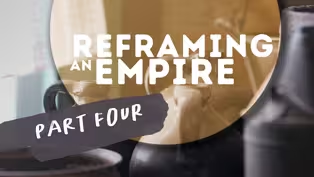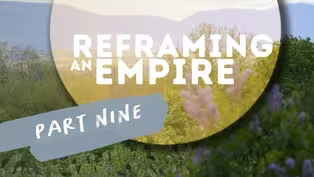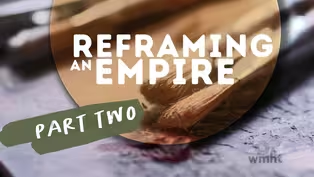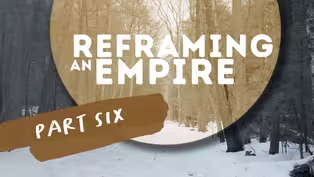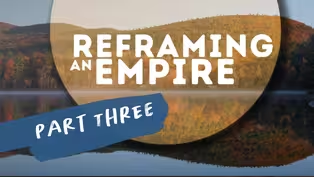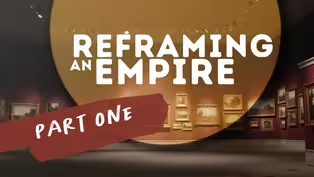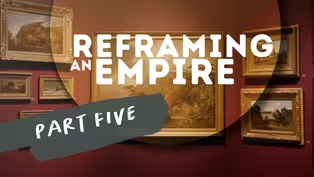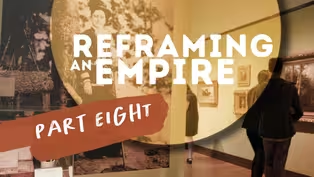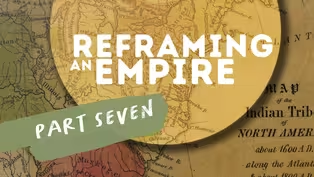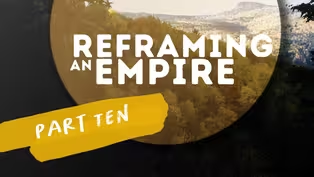WMHT Specials
Reframing an Empire
Special | 56m 46sVideo has Closed Captions
Explore the life and work of Thomas Cole as he witnessed the birth of an new nation.
Thomas Cole’s life and work coincide with a pivotal period in American history. Before Cole’s eyes and on his canvas, the newly formed nation would find a vision of its identity born and its future questioned. American history fixates on 1776 and 1865, but in the period between lies a rich and under-explored territory.
Problems playing video? | Closed Captioning Feedback
Problems playing video? | Closed Captioning Feedback
WMHT Specials is a local public television program presented by WMHT
Reframing An Empire is made possible by Albany Med Health System.
WMHT Specials
Reframing an Empire
Special | 56m 46sVideo has Closed Captions
Thomas Cole’s life and work coincide with a pivotal period in American history. Before Cole’s eyes and on his canvas, the newly formed nation would find a vision of its identity born and its future questioned. American history fixates on 1776 and 1865, but in the period between lies a rich and under-explored territory.
Problems playing video? | Closed Captioning Feedback
How to Watch WMHT Specials
WMHT Specials is available to stream on pbs.org and the free PBS App, available on iPhone, Apple TV, Android TV, Android smartphones, Amazon Fire TV, Amazon Fire Tablet, Roku, Samsung Smart TV, and Vizio.
(bright music) - Thomas Cole's were an answer to what the other writers and artists and thinkers at the time were looking for, which is, "What is this country going to be?
What is our culture?
What is our identity? "
(gentle music) - Paintings serve as sociopolitical and economic documents.
We're able to visually read them as a broader discussion of what's happening at a time and place.
- I would love to have seen the area when my ancestors were here.
- There's a longer history to not only omitting some people's stories, but also if we start to put them into place, we can better understand the world we live in today.
- The history of this country is really important to understand in order to understand why we are the way we are now.
(gentle music) - [Speaker] Sponsored in part by the Albany Med Health System.
And by Robert and Doris Fischer Malesardi.
(gears spinning) - I'd like people to think about art as a primary source document.
In museums, we talk a lot about primary sources, which means you look at the actual letter that somebody wrote, rather than looking at someone's writing, describing the letter.
Go back to the original document, and paintings are original documents.
They will show you firsthand what someone thought and what someone was trying to express.
And that way you can learn about history directly.
One of the things that we are addressing through this site, in terms of the most urgent social issues, the most urgent educational issues, is the fact that America was built by a very big, diverse population.
And one of the things that we noticed going back and in our interpretation, is that people came away with a misunderstanding.
They thought that Thomas Cole, this one man, did everything here.
We were talking about him so much, they thought he did the gardens and cooked the food and took care of the house and washed the windows and created all this art.
Of course, that was impossible.
(gentle music) We are sitting here in Thomas Cole's home.
And it is also the home of Maria Cole and about 11 other people.
They all lived here in Catskill, New York, where we have a view of the Catskill Mountains here off to my left.
And the property used to go all the way to the Hudson River, off here to my right.
(gentle music) - Thomas Cole created a very particular aesthetic relationship to nature, where nature is something beautiful to look at.
And it's a scene, it's scenery, it's an aesthetic.
It's something to visually consume, and it's not necessarily a place that we are part of.
And it's not a home.
It's more of actually another type of resource, which is a visual resource of the beauty and what that says about the national identity of this country.
(gentle music) - When we think about the American landscape movement, the Hudson River School in particular, an artist like Thomas Cole that we consider to be a founding father of the genre, really creates these moments where Americans are seeing the landscape, many of them for the first time.
Places that would become famous sites for vacations and traversing the landscape.
It's a time period in which so soon, really, after the completion of the American Revolution, and we're in this moments of, "Is democracy going to work?
Is it just an experiment? "
And so the American landscape comes to represent something incredibly important about our own sense of national identity.
This is what we fought for, and this is what it looks like.
For many people, these images became these nostalgic salves.
People looked to the landscape, these almost idealistic visions of America's past and present as a way to understand the current moment.
- Thomas Cole's life is very interesting because he moved to the United States after having seen the Industrial Revolution in England, and he had his concerns with him.
- Well, he comes here as a teenager, an older teenager.
And he's leaving a very polluted industrial environment that he's growing up in, in an England that's filled with soot and dirt.
- And in 1825, when he went to New York for the first time, and he saw the Catskills, he was so touched, and was so moved by the beauty of this land that he created these paintings and really urged people to consider what is being lost with by industry.
What is now being transformed through industry.
(gentle music) - Thomas Cole was a trailblazer.
I mean, he paved the way for dozens of artists who followed him.
History tells us that he created a few paintings and he brought them to New York City and they sold right away.
And it doesn't take long for other artists to notice that's going on.
And there are some very talented artists around.
And so this spawns interest, this is an incentive to create landscapes.
So Cole gets this American art form started.
- I think looking at Thomas Cole's collection is important.
And it's important because this is one person, in this whole landscape, and how they saw their environment and also how they wanted other people to see it, right?
There's this romanticization of it.
There's the religious elements of the Second Great Awakening and God's gift in particular to Americans and to New Yorkers here in this area, the wilderness and manhood, that's all part of it.
- Over the course of the paintings that we have of his, you can see an evolution.
That evolution is it's there in his work.
That's why I was thinking that if he had lived longer, we really don't know where that would have gone.
He never got to a point where he, I felt, I feel he matured as an artist.
And maybe that's also part of what was going on with his expressions that somehow seemed a bit naive about man's relationship with divinity.
Maybe time would've changed his thoughts about those things.
Cole inspired others.
And in the work of the artists that followed him, like Frederic Church, like Asher B. Durand, like Jasper Cropsey, Frederick Kensett, we don't see the same kind of pious storyline, this romantic story that has to do with human tragedy or human experience.
But we see the space, we see the environment.
A sunset, maybe, that we felt, or that we've been in that environment of that storm.
That's not a Cole storm.
A Cole storm is about the hand of God sweeping across the sky.
(gentle music) (gentle music continues) - Thomas Cole was an immigrant to this country.
He came from England when he was a teenager.
And so he brings an immigrant experience, but he also just brings the experience of one person.
And he was a White man from Europe.
I think what we're trying to also show here is that there are a lot of other people that were right here on the ground, doing important work, that have a different perspective.
And that it was only through looking at the entire household and all of the people working here and Thomas Cole's sisters.
And when you look at the entire diverse population of who was working here, you get a picture of the diverse population that was creating America at that time.
(gentle music) - 1819 New York becomes larger in population than Virginia.
Certainly by the end of the 19th century, it's known as the Empire State.
(gentle music) - What's important to talk about is that empires are not neutral.
Empires are very powerful.
We often talk about New York state as the Empire State, as if it's this neutral thing.
And we talk about the beginning of this nation and the time when Thomas Cole was representing the aesthetic, the scenery of this country.
It was at a very serious moment in history, of active erasure and active dispossession of Indigenous lands.
(gentle music) - During this era, while there was change all around the United States, most of the change was happening in New York.
And it was the center of this political thought and reform movements and all of these things happening.
They were happening in New York.
They weren't happening necessarily in other places.
(gentle music) In 1800, the population of New York state was less than 600,000 people for the entire state.
By 1860, it was just under four million.
So you can see, in that 60 years, a continual increase in population.
And a lot of that was due to immigration.
(gentle music) New York is the center of so much of this economic revolution and industrial revolution, but also transportation revolution.
So Robert Fulton and the steamboat really opened the Hudson and connected New York City to Albany and all the places along the Hudson, and really made travel along the Hudson much easier, much quicker, much more accessible.
So that's kind of like step one, right?
Instead of using more primitive methods of sail or rowing, or other types of boating up and down the Hudson, you're able to use the steamboat and go against the current, and do it in a much faster way.
And then the Erie Canal was the first major big, I think game changer, so to speak.
- Thomas Cole moved to the United States in 1818, which was one year after the beginning of construction on the Erie Canal.
The Hudson River School, which is this art movement that he played a big role in founding, began in 1825, which is exactly when the Erie Canal opened.
- As a result of the Erie Canal, really did attract not only people that worked on building the canal, but others who would benefit from the trade.
So merchants and business people began settling in the cities along the canal, including Buffalo and Rochester.
And that really made New York the center of this trade from the west and the new Western states that were being developed in the country.
That trade was able now to go across New York on the canal and down the Hudson and to New York Harbor, which by the 1850s, New York City was the largest city in the country.
It was the first city to have more than a million people.
- Thomas Cole's work has something to do with forging that national identity and national aesthetic, which has a lot to do with wilderness.
And the Erie Canal discourse, the way that we often talk about the Erie Canal through time, and it's a very powerful history, is that the Erie Canal transformed wilderness into the industrial empire of New York state, which is the Empire State.
- One of the things that is often missed out of the narrative is the words that we use to describe the land.
So wild, untamed, savage even.
Those words were also used to describe the original inhabitants of the land.
I think the reason those terms are used from the onset of colonization is because when you have people coming over, whether it was for religious freedom, or to start new lives or what have you, they came onto shores of a land that was already inhabited by hundreds of millions of people, but it was people who worked in one with the land.
So when settlers start coming in, they're working against the land.
And the land is wild, it's covered in trees.
How are we gonna create these new cities if we have all of these trees around here?
So you have to cultivate the land in a way that promotes progress.
- There were huge environmental impacts to all of these changes.
But the primary one at the foundation of all of this is the dispossession of Haudenosaunee lands.
Because when we're talking about the development and the progress of New York state, we have to ask, "Who is this development for?
Who designed this development?
What does this mean? "
And a lot of Thomas Cole's paintings work in tension with that, because he also, he was conflicted about the industrial changes happening in New York.
And he was concerned about their environmental impact.
- He looked at this view every day, starting in the 1820s, and then 1830s when he lived here, and then into the 1840s.
And during that time period, it was dramatically changed.
It was cleared of trees, there was industry moving in.
There was the tanning industry that cleared the hemlocks.
They used the bark of the hemlock trees to tan leather.
The railroads came through.
He couldn't believe that in a, what he called a civilized nation, there could be such destruction and such thoughtless destruction.
- When Thomas Cole talked about the scenery of American landscape, he was making very serious claims about whose land they were on, whose scenery this is.
And he made claims that, "This is our land, this is our scenery to enjoy. "
- I would love to have seen the area when my ancestors were here and to not see all the buildings and skyscrapers and the polluted water that we now have.
It would've been completely different back then.
So while I understand what Cole is saying in wanting to protect the land from industry and all of that, in a way, you're again leaving out the people who originally took care of it.
Because if you're talking about it in a way that the land was virtually untouched, we cared for the land as if it was a living relative of ours, only taking what we need, being stewards of it, replenishing when needed.
So of course we were taking care of the land in a way that looked amazing.
(gentle music) Well, I think one of the things that Thomas Cole leaves out of his paintings, not only is the Indigenous people, but the fact that the Indigenous people weren't here anymore.
So colonization first happened in this area all the way back in 1609, when Henry Hudson came sailing down the river that now bears his name.
And from that moment on, with the inception of the Beaver Wars and the fur trade and all of that, Indigenous people were just continuously moved out of the area.
- Environmental conversations need to begin by addressing inequality.
Because environmental problems are not spread evenly amongst peoples.
Environmental problems are significantly about inequality and about race, which is a colonial idea.
A lot of environmental problems that perhaps Thomas Cole would react to requires us to talk about systems of harm, like industry, but also systems of harm like colonization, which is the idea that a powerful group of people can take over a land and use the people and use the land for their resources.
(gentle music) - The Indian Removal Act, I think, is one of the worst policies in our nation's history and certainly extremely damaging to New York state.
Generally, the Indian Removal Act was an attempt by the federal government to move the Indigenous people from the eastern part of the country to the western part of the country, so west of the Mississippi River.
And this was done basically because the government wanted the lands.
Thinking of land and nature as kind of a limitless resource that, and not taking into account at all, the strong ties that Indigenous people had to their lands.
And it showed a real misunderstanding, or intentional misunderstanding of native culture to think that it would just be easy to move people to completely different lands.
In New York, it plays out, the Second Buffalo Creek Treaty of 1838, which was an attempt to buy the Ogden Land Company to basically take or purchase the Haudenosaunee lands and move them west of the Mississippi.
It was an invalid treaty to begin with, because federal government never ratified it.
So it would essentially a treaty between a private entity and the Haudenosaunee, which is not allowable by law.
Also, the Haudenosaunee were lied to, and taken advantage of throughout this, and told that they would be receiving money and lands that they never would receive.
And long story short is, many Haudenosaunee people were displaced as a result of this.
- So you had the Lenape people, whose area is from a little bit south of Albany and Hudson and into New York City.
And that area is the area we call Lenapehoking, which is land of the Lenape.
And of course it took up parts of Pennsylvania and Delaware as well.
But they had their own trail of tears in being removed from the land that they called home.
So it's, their removal happened in the late 1700s, early 1800s, and they were moved across the country, to Indiana, Ohio.
And today they have two reservations in the state of Oklahoma and there's also some in Canada as well.
You also had the Mohican people, who were North Hudson, North Albany, Lake Champlain area, and then western Massachusetts who were also forced to, first of all, western parts of New York, but then also they went into Ohio, Indiana, and then later Wisconsin.
And so that's where they're at today.
You had Haudenosaunee tribes who were also removed from the area.
They were primarily on the western side of the river, the Hudson River, but they were also removed.
And this, all of this removal happened, almost immediately after the American Revolution.
And many of these tribes, with the exception of some of the Haudenosaunee tribes, fought on the side of the Patriots.
So fought for freedom for the United States, my ancestors included, I'm Oneida and I am Mohican.
And both of those tribes fought on side of the Patriots.
And then right afterwards, were removed from the land.
So there weren't many tribes in the northeastern part of the United States at all.
Whether it was in New York, Massachusetts, Connecticut, Delaware, all of those tribes.
The tribes that now make, or the states that now make up New England.
They were almost virtually gone by the time Cole would have been around.
And definitely by the time of the Civil War, starting in 1860.
(somber music) (birds chirping) (marching band playing) - The time period when Thomas Cole was painting was a very disruptive, and I would say a stressful time for a lot of Americans.
And Thomas Cole certainly felt that.
So much was changing.
They were largely in a rural country, farming was predominant.
And then all of a sudden, these industrial changes came in.
And it displaced a lot of people who had been used to the old way of life.
In addition to that, it was the time of Andrew Jackson's presidency.
And so the whole nature of politics was changed and people were very afraid of what that might mean for our country.
It was in the lead up to the Civil War.
And we noticed that we were fighting with each other and not getting along, and it wasn't that easy to have a harmonious country in which we agreed on everything.
So a lot of the things that we are now dealing with in American life have its roots in this period when Thomas Cole was working.
- Yeah, the history between really 1800 and 1848 is based a lot on locality, you can say that.
So there is the war of 1812, which many historians look at because it's international, it's a major important piece, especially in the northern part of New York state, and in the southern parts.
This is also, in New York, the era of the Great Awakening.
So we have this movement of religious revivalism that's taking place.
- Many of the immigrants from New England were evangelical Protestants and brought their religious beliefs to upstate New York.
And it became what was known as the Burned-Over District during the Second Great Awakening because there was this religious fervor and there was new religions being developed.
Like Mormonism for example, began in New York state in Palmyra.
The Millerites began in Washington County.
The temperance movement became a very large movement in New York state.
The suffrage movement in New York state began in Seneca Falls with the first women's suffrage convention.
Elizabeth Cady Stanton being the driving force behind that, or one of the driving forces behind that.
It was a time of great change economically, and with demographics, but it was also a time of great change as far as new movements and new religious beliefs.
- We also have a lot of international changes when it comes to trade.
So you have larger historians or the field in general, focusing on a lot of those kind of national and international things.
In New York state, they're connecting to those ideas, but they tend not to look so much at the diversity in the state.
They'll look at local communities because they're along the Erie Canal.
And those get built during that time.
And again, that's connecting to the trade, and how urban developments or urban development happens, but not necessarily how the people themselves are operating in all those different locations and how that connects to national politics, unless it has to do with money.
Though abolition is unfolding at the same time, and that tends to be connected to say, Black history, largely.
When you just look at general history, it tends to be economic, it tends to be war, and then state focused on the big investments that are happening.
- The wealth and the success of the United States was predicated on the sort of oppression of Indigenous persons and its enslaved Black population as well.
Whenever we think about, I think the success of American culture, I think we also need to look during that time period at persons who were oppressed economically to make it possible for the United States to thrive.
And then to be able to enter into this World War at the second kind of half of the period, where we're looking at.
(calming music) (gentle singing) (gentle singing continues) - One of the major myths to debunk about the period between 1800 and 1848 is that slavery didn't exist in the North, because it existed everywhere.
In the colonies, and then in early America.
The other is that when slavery was abolished in the free states, that that meant people immediately became free and gained all their civil rights.
Because they did not.
And New York actually had the largest population of enslaved people outside the South, during that early 1800 period.
So you have a lot of people in different locations who are finding all kinds of ways to say, "You're not gonna continue to hold us in bondage.
And we're gonna have to find a way to do something about it. "
And that's when the legislators really start to listen and look at controlling that.
Creating policies and plans to minimize its immediate effect on enslavers, really.
- So during Cole's time, when he comes up here, a lot of Black persons are receiving their manumissions, which are the kind of legal documents stating their freedom.
But there's still these sort of threats to their freedom.
And some people aren't manumitted until 1827, or even later.
And so while he's here, slavery is very much still a practice.
And you see that appear on census documents even.
He likely saw it and experienced it in various forms, like around Catskill, and in the surrounding regions.
- Slavery really phased out in free states, but then you see policies that are racialized that follow them.
And so I think those are really the major, some of the major things, especially about how African-Americans lived during this time period that I'd like people to know more about, and not believe that once a state was free, everybody just gained equal rights like everyone else did.
That did not happen.
(rhythmic thumping) So immediately, in the aftermath of the American Revolution, politicians in New York are trying to decide how to stay true to this idea of freedom from the American Revolution.
And you have enslaved people, and some free people of African descent who are demanding that slavery is abolished.
And so what the politicians start to talk about is what will the state look like and who will do the labor if enslaved people are free, but also that enslaved people might retaliate against their former enslavers for breaking up their families and the horrible abuses that they experienced.
So their initial debate is on, "How do you do this?
Is it going to be immediate?
Or we pick a date and all enslaved people are free?
Or is it gonna be gradual? "
Which gives us time to still use the labor of our enslaved people and to figure out how we will maybe compensate enslavers for now their loss.
And also then as people start to gradually become free, to see if they'll work, right?
To see what will unfold.
So it's kind of a little bit more like a test, rather than a commitment.
(men singing) - Thomas Thomson was the uncle of Maria Bartow Cole, who married Thomas Cole.
So Thomas Thomson dies in 1821.
So him and Cole never actually meet, but it was essentially Thomas Thomson's wealth and business ventures that established the home that Thomas Cole would move into and come to love and become kind of famous for living in this really beautiful and pastoral space.
(gentle music) What we find out is that Thomson was really a businessman at heart and was actively involved in enslaving people in Demerara because he saw it as this business opportunity.
And he's kind of the perfect example of someone in the US, profiting from the institution of slavery.
The 1840 census of the home cites that 11 people were living here, including a free Black woman who is recorded and cited without a name on this particular record.
- Whoever was enslaved or in Black servitude, or performing Black labor, is really kind of erased from a lot of recorded documents from any family.
It's really like this level of very invisibleized labor.
Not just in this family, but in a lot of families in the valley.
- Understanding the role and importance of slavery in the American economy, in settlement patterns, in even wills and bequeathed between family members of enslaved people, but then also the tenacity of formerly enslaved people to put one foot in front of the other and to demand civil rights in states that are practicing racialized slavery, but also claim to be free states and have eliminated slavery, means that it's expanding our understanding at the time of human rights.
And the nation at large, wasn't really ready for that kind of conversation.
- History is written from one point of view.
It is written from a cisgendered, White male point of view.
All the time, usually victorious.
So who wrote about the American Revolution, those who were in it.
Who writes about the Civil War, the winners, right?
World War I, World War II, all of that.
Histories written from one point of view.
And there are so many other things happening at the same time that we have events happening that different narratives can intersect.
And when you intersect the different narratives and you get a fuller narrative, the story is way cooler.
(gentle music) - Somehow in the 20th century, when the history of American landscape painting was being written and celebrated, they left out the women.
(gentle music) - Today we're at the Thomas Cole National Historic Site in Catskill, New York.
And we're here for the exhibition, "Susie Barstow and Her Circle," which is part of the larger exhibition project here called" Women Reframe American Landscape. "
And behind me is this wonderful image of Susie Barstow.
So you can see for yourself who the artist is and what she looked like and what she wore as she was tramping about the Catskills in the mid-19th century.
The room is filled with beautiful examples of her artistry, as well as the works of artists with whom she sketched and hiked and exhibited.
Other women such as Laura Woodward, Mary Josephine Walters, Julie Hart Beers, Eliza Greatorex, and Charlotte Buell Coman.
By the time of Susie's death in 1923, her reputation was well established.
As was the reputation of many other women artists with whom she painted and exhibited.
And there seems to be this moment of art historical amnesia by mid-century that's written these women out of the history books and out of exhibitions and monographs and articles.
But now is the time that we bring them back into the fold.
This beautiful landscape by Susie Barstow, with its framing boughs, really invites the viewer along this stream in the foreground back into wooded seclusion.
This was painted in 1865.
And for many artists of the Hudson River School, the Civil War, as devastating as it was in America, created a moment for artists to paint scenes that offered maybe a bit of repose, silent spaces, hopeful landscapes that maybe the United States would become reunited through the landscape itself.
Susie Barstow is certainly part of this tradition.
Her style is often likened to artists such as Asher Durand, a name that the public today might be more familiar with.
Now I think it's time for Susie Barstow to be the name that people associate with these types of beautiful, intimate landscapes.
(gentle music) When I was a graduate student, I was writing my dissertation about Thomas Cole and the Course of Empire.
and I was able to mine these incredible archival documents and all these letters by Thomas Cole.
In and amongst these letters are his correspondence with his sister Sarah Cole.
And I'd never learned about Sarah in any art history class, and I was fascinated who she was.
And the more work and the more research I had done into Sarah, it became apparent that she was a professional artist.
She was right there with Thomas.
And in fact, there were times in which she provided the encouragement that he needed when he felt that his talent was fading.
(gentle music) - Sarah Cole was about four years Thomas Cole's junior.
Both moved from England in 1817.
So at that time, Sarah was 13 years old.
And Thomas Cole pretty quickly, upon immigrating to the United States, he started pursuing a career in the arts, in the fine arts.
This would've been something Sarah and her two sisters would've been aware of.
And there's actually a report of the sisters doing classes at a seminary with Thomas.
And Thomas was teaching art classes there.
So it's possible that they were taking some lessons from Thomas or learning alongside him.
And we know that Sarah started painting as early as the 1830s.
She was part of this artistic network and she was creating as well as etchings, which was not a very common technique at the time.
And there'd be an etching revival actually in the 1880s, after she died.
And she was someone to really help spearhead that, unlike Thomas Cole, who focused more on oil painting during his career.
(gentle music) - In the 19th century, there were discussions about whether or not you could find a female line.
Did women hold paintbrush differently than men?
And it became important to discern this difference between men and women.
And what we find today, the reason why this exhibition is so important is because regardless of gender, these are works that celebrate the beauty and awe that these artists found in the American landscape.
The historical women that we're showcasing are working in concert with the contemporary women artist to show you that there is this continuum, this ongoing appreciation for this curiosity about the American landscape.
Many of these conversations are meant to spark questions.
Even contend with our own uneasy history, but ultimately come back to celebrate what is unique and beautiful about the American landscape.
- By studying these women, it's a way of redressing these figures who were just as central to the movement as people like Thomas Cole or Frederic Church, but who we've forgotten about.
And I think, for me at least, it was, I think my understanding of women at the time was that they were just at home and they were very confined to these gender roles.
But it's so remarkable to see how many women were able to be so mobile, hiking throughout the country, and painting, and to such a great scale, and with such originality.
So I think it's really empowering for women today to read about these women.
And it also, I think it's empowering to remember these women, and remember their stories and how they've shaped American art today.
(gentle music) (gentle music continues) (gentle music continues) - We owe a great deal of thanks to artists like Susie Barstow and Sarah Cole and Louisa Davis Minot.
These founding mothers of the Hudson River School, of this movement of the American landscape, allows us to continue to celebrate and know and promote women artists who are dealing, who are contending with, who are painting, sculpting, immersing themselves in the American landscape experience.
- Landscape is a term, is a construction.
And landscape, perhaps those made by Thomas Cole and others in the 19th century as a single point perspective on a canvas with a horizon line, doesn't always reflect the complexities of land.
Land is something that has political, economic, historic, cultural, spiritual, ecological and personal realities.
And so with this exhibition, we are really hoping that some of our visitors will think more deeply about the history of American landscape art, but also their own relationship and connection to land today.
(gentle music) - We live in a time, I think now, where there are more relevant perspectives to kind of mine and to look at too.
And so while they're important figures, and their ideas carry to today, we also are living in a completely different time, racially, politically, and socially.
And so there are definitely, we definitely have room for different voices, I think.
Like I have personally more of a focus on contemporary material, because I think it's what's most important and relevant to people now.
My family's from Vietnam, a lot of them.
And so I really, I think, value then understanding the perspectives of immigrant populations too, and think it's sort of time for those artists and for those persons to be platformed more.
Certainly I think a lot of the Hudson River School artists have been centered for so long, that I think decentering them is actually a really beneficial thing.
(gentle music) (gentle music continues) (gentle music continues) (gentle music continues) - I'm installing a piece made specifically for Thomas Cole.
And it's called "Displaced. "
My practice deals with everyday objects, again, so familiar, so every day, that we don't even think about it.
We don't assume anything about its origins, its purpose, what happens after I use it.
And those sort of slippery spaces of these objects accumulate over time.
And then culturally, it has become all-consuming.
And I think that it really changes us when we see it all.
It's like when you see the view, you cannot forget it.
And it's Thomas Cole all over when you paint the view, someone cannot forget it.
So I'm hoping that there is some change that evokes in visualizing, not just the beauty, but our waste.
(gentle music) You see these crates, and it's actually the crates that Thomas Cole's paintings and artifacts were used in a previous exhibition.
So I'm using the leftover of previous exhibitions of his work as the structure and part of my artwork.
Then what we've done was also take the local dirt and we're gonna fill the crates with the dirt of the site.
And then I brought my studio remnants, the leftovers of my artistic production, the waste that I've saved, and to kind of bury them within the crates as an artwork.
(gentle music) I've always enjoyed working in conjunction to a site because the site has this history, an incredible rich history, or an artistic one.
But at the same time, he wasn't the only one who was here.
So him discovering this land and painting these beautiful landscapes also displaced the Indigenous.
So I always think that there's also invisible populations and narratives and histories that are not told, not seen, not visible, and someone gets to claim it, and be known or famous for it.
But we live in an ecosystem.
I'm trying to kind of reveal, unfold, some of the other narratives that are often hidden.
(gentle music) - As the historic Coleman studios of an artist, we continue to engage and work with contemporary artists because we really believe in the power of art and ideas to help us think about and engage with the issues that matter most to us right now in our present moment.
And so, if you can imagine, Thomas Cole was here in the 1800s and he was making contemporary art and landscape paintings in his studio.
And people from all over were coming to see the latest in contemporary landscape art.
So today we continue to activate this place as a place for ideas and creativity and art, and we engage contemporary artists to create site-specific installations and exhibitions.
- The perspectives of the contemporary artists in our show are really important and I think will help visitors think deeply about their own relationship to land.
We have artists such as Teresita Fernandez, who is asking us to look below the surface and seeing the ways in which we can interact with land in sustainable ways.
We also have artists such as Saya Woolfalk, the work of the artist behind me, who is thinking about a future when women are able to merge with plants that are not a part of the landscape, but are a part of the landscape.
So I think this show, I hope, encourages visitors to think about their future and our future together in relationship with land.
(gentle music) (gentle music continues) - We have all the people here, in a way.
We have all the characters, we have the full story of how America was crafted on the ground, all the messy details.
And so when you just look at an artwork on its own, it can tell you a lot, and it's very beautiful.
But when you look at an artwork in the context in which it was made, I think you just get a lot bigger, richer picture of how that art came about, what it means.
The context is kinda everything.
We have a real unique opportunity in historic house museums to show that whole big household, the whole big range of people that made the country happen.
(gentle music) (gentle music continues) - My goal as a historian, and especially one who focuses on New York state, is really to inspire people to ask more questions.
I want people to read about race relations and gender relations, and to think about how that may have looked and felt, in say, 1820, in their own community.
And then think about what our values are today about family and economic success or education, even about our neighbors.
And in looking at the past, say, "Oh, these aren't players who are so disconnected from our same values today. "
They're people who are living in their time with the practice of slavery in part of the country, with emancipation rolling out really unevenly in other parts of the country.
With race relations really being hardened into a racial hierarchy during this period.
With Indigenous populations all over the state, still moving in and moving through and asking and demanding for some respect.
And women saying, "Wait, we're doing a lot of work here! "
Right?
We are really the backbone of American families, regardless of what your racial or ethnic background is, right?
And so I want people to start to ask those questions and say, "Well, a person like me, my story is just as relevant as the next story.
And I wanna know how mine and someone else's connect, in say, 1834. "
- One thing is like always being kind of open to critical interpretations and remaining critical too, understanding that these historic figures can be incredibly important historically, but also fallible.
And I think important to hold our historic figures to the moral standards of today also.
I mean, and reckoning with that history for sure.
Yeah, and I think it's also sourcing your information and knowledge from those groups of people who were most affected by some of these courses of history.
That really gives you the kind of full-bodied view of the movement and what it implied and how it's affected us.
Because for a very long time, of course, we had art history has been this sort of like imperial and colonial and mainly White discipline.
And it's the only way that we kind of break out of that is the inclusivity of other perspectives and voices too.
The more the merrier, I think.
The more perspective and the more critical lenses, the better.
And we're seeing that now.
- In what ways do we have things in common with others?
How do we find that?
And then how do we present it so people can see that there's a longer history in the United States to not only omitting some people's stories.
But also if we start to put them into place, we can better understand the world we live in today.
We can start to trace back some of those kind of -isms that everybody's challenged with.
And we can also find ways that people work together in the past that haven't been unearthed yet.
(gentle music) - We survived.
My ancestors survived so that I can sit here.
And parents survived so they could raise their children.
People went underground, hid their language, and hid their religion so they could secretly pass it on.
So tradition still lived.
It just lived underground.
And because of that, because of those brave people who held onto language, religion, culture, all of that, we're able to still see remnants of it today.
So we survived.
(somber music) - I'm hoping that we have shown people that the history has a lot to tell us about today.
And I'm hoping that people come away with a feeling that they too, have agency in their world.
Thomas Cole tried to change the world with his paintings.
He tried to change people's hearts.
And one person can make a really big impact on the world.
Every person has that opportunity, whether it's through art, writing, just being a person in the world interacting.
I think I feel that inspiration when I'm here, that I have the ability to go out into the world and make a change in the world, as I hope that everyone else feels too.
(gentle music) - [Speaker] Sponsored in part by Albany Medical Health Systems, and by Robert and Doris Fischer Malesardi.
Video has Closed Captions
Clip: Special | 7m | Thomas Cole's art mirrors a nation in turmoil, showcasing America's diverse past. (7m)
Contemporary Artists Spotlight
Video has Closed Captions
Clip: Special | 7m 59s | The Thomas Cole House looks in new directions with their show of contemporary practices. (7m 59s)
Discovering the Legacy of Thomas Cole
Video has Closed Captions
Clip: Special | 6m | Journey into the life & art of Hudson River School founder Thomas Cole. (6m)
Video has Closed Captions
Clip: Special | 6m 59s | Striving to understand humanity and the impact of slavery during the lifetime Thomas Cole. (6m 59s)
Video has Closed Captions
Clip: Special | 6m 59s | Uncover the truth behind the 'untouched' American landscape. (6m 59s)
Video has Closed Captions
Clip: Special | 6m 59s | Thomas Cole's art is a treasure, yet its untold stories are significant. (6m 59s)
Video has Closed Captions
Clip: Special | 6m 21s | A fresh look at America's past, re-evaluating historic narratives in Reframing an Empire. (6m 21s)
Video has Closed Captions
Clip: Special | 6m 59s | It's time that we recognize and remember the Mothers of the American Landscape movement. (6m 59s)
Video has Closed Captions
Clip: Special | 6m 59s | Many Indigenous tribes had already been displaced before Thomas Cole's arrival in NY. (6m 59s)
Video has Closed Captions
Clip: Special | 6m 59s | Learn why it's important to take into account a critical lens and students of our history. (6m 59s)
Providing Support for PBS.org
Learn Moreabout PBS online sponsorshipSupport for PBS provided by:
WMHT Specials is a local public television program presented by WMHT
Reframing An Empire is made possible by Albany Med Health System.
